In less than a year, the Air Force has brought into combat service its newest and most lethal unmanned aerial vehicle, the MQ-9 Reaper. A special squadron is simultaneously developing tactics, training flight crews, and operating the UAV in battle. This is taking place even though operational testing has barely begun and a full production decision is still a year off.
The Reaper drew first blood on Oct. 27, 2007, when it fired a Hellfire at insurgents attacking US troops in Afghanistan. Eleven days later, a Reaper dropped its first pair of laser guided bombs, silencing Afghan insurgents firing at US forces.
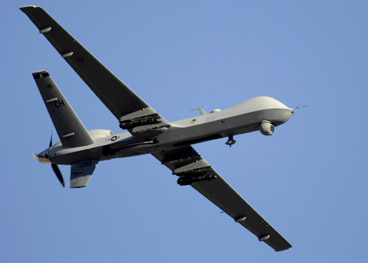 |
Reaper in flight over Nellis AFB, Nev. (USAF photo by MSgt. Robert W. Valenca) |
The Reaper’s success is important if, as many believe, it is the first of a new breed of large unmanned combat aircraft.
It was in late February 2006 that Gen. Ronald E. Keys, then commander of Air Combat Command, ordered acceleration of Reaper to operational service. Much has happened since then, said Lt. Col. Jonathan Greene, commander of the first MQ-9 unit, the 42nd Attack Squadron. The 42nd is based at Creech AFB, Nev., about 45 miles northwest of Nellis AFB, Nev.
Keys’ order responded to demands of commanders in Iraq and Afghanistan for more “persistent” intelligence-surveillance-reconnaissance (ISR) aircraft as well as additional strike and close air support assets.
Greene said he and one other officer “started out in a cubicle at Nellis” with a “blank sheet of paper,” assigned the task of inventing the first true unmanned combat aircraft squadron. By March 2006, he had a budget, a building at Creech, one aircraft, and orders to get Reaper into the fight by the fall. On Sept. 27, 2007, the first Reaper to fly a combat mission was launched from a base in Afghanistan.
The Reaper evolved from the MQ-1 Predator, but is a very different machine, with a different mission.
With a 66-foot wingspan, the Reaper is roughly the size of the A-10 attack airplane, and can carry 3,000 pounds of weapons—more than 10 times the capacity of the Predator. It can fly at up to 288 miles per hour, allowing it to transit from an operating base to a patrol area almost twice as fast as the Predator. The typical on-station time is 15 hours. It can cruise at 50,000 feet “clean”—that is, without weapons—but typically flies at about 30,000 feet, fully loaded.
“People call it ‘Predator on steroids,’ but it’s really more than that,” Greene asserted.
The Predator is described as a “killer scout”—dedicated chiefly to ISR but with a limited ability to shoot at targets of opportunity. However, the Reaper is defined as a “hunter killer,” meaning that it is dedicated to strike and yet still has sizeable ISR capabilities, including electro-optical, infrared, low-light TV, and synthetic aperture radar.
Air Combat Command compares the Reaper less to a Predator than to an F-16 fighter, which is meant to attack ground targets but which can use targeting pods to collect and transmit full-motion video to air operations centers and troops on the ground.
Guiding the Reaper
The typical Reaper weapons load includes two GBU-12 laser guided bombs and four AGM-114 Hellfire laser guided missiles, but it can carry up to four LGBs. It eventually will carry both 500-pound Joint Direct Attack Munitions and 250-pound Small Diameter Bombs. These GPS guided weapons will allow Reaper to precisely attack targets through bad weather.
The Reaper crew pairs an officer pilot with one enlisted sensor operator. They sit side by side in a trailer that can be set up almost anywhere, but that for now resides at Creech, next to a bank of satellite dish antennas.
The pilot sits on the left of the “cockpit,” facing a main screen and several smaller screens showing him pictures through the aircraft’s nose camera, its sensor turret, and displays of the status of various systems. He has joysticks that simulate throttle and stick, but there’s a keyboard in front of him. Some of the screens are for instant-messaging type chat with various levels of command and control, such as the air operations center for US Central Command Air Forces. He can also communicate by voice or text with troops on the ground, half a world away.
The sensor operator’s station is very much like the pilot’s, but is more geared toward operating the cameras, infrared system, radar, and other sensors onboard.
Except for Greene, none of the Reaper pilots have prior experience with the Predator. They are experienced in F-15E, F-16, A-10, B-1, and B-52 aircraft.
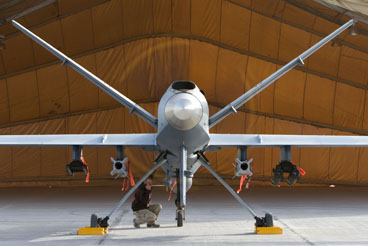 |
An MQ-9 Reaper undergoes inspection in Afghanistan. (USAF photo) |
The more senior sensor operators come from the Predator force. “The majority of them are fresh out of tech school, … imagery analysts by trade,” Greene noted. “But that’s going to change. Our next group will be [enlisted] aircrew.”
Greene said that his sensor operators have done a great job stepping up to the big responsibilities that go with flying the Reaper, but many have been in the Air Force less than a year, and officials decided that more seasoned aircrew will be a good fit.
Coming into the job, enlisted flight personnel “have a little more airmanship. They’ve been on an airplane, they know what it means to be on an aircrew, and they understand checklist procedures and how airplanes work.” The next batch of sensor operators will all be “sensor operators from other airborne platforms.”
After a training course of only a few months, graduates go directly to combat missions and help train new crews in how to fly and fight with the Reaper. In most systems, it usually takes many hours to upgrade to instructor, but Reaper crews do so not long after emerging from the “schoolhouse” themselves.
The trailer housing the flight crew is called a ground control station. It is connected by fiber-optic cable to a satellite uplink in Europe, which then communicates with the aircraft via satellite. That way, all radio communications can be “line-of-sight” in nature.
Real Pilots
Despite the speed of transmission, there’s still a two-second delay between a pilot’s input and feedback on his screen. During most of a mission, the delay doesn’t matter. However, for takeoff and landing, a local pilot takes over the aircraft, and there is “no delay” in feedback, Greene reported.
Taking off and landing the Reaper is a challenge, he said, because there’s only one view—through the nose camera—and no peripheral vision, stick pressure, sound, or “seat of the pants” sensations. The aircraft must be flown very precisely to avoid overcontrol, and can be especially tough to land in a crosswind. There’s “almost no flare” in landing.
Greene said that a more sophisticated “cockpit,” with more of these cues, is in the works but has yet to be matured.
The Reaper crew is included in the air tasking order issued by CENTAF. The crew briefs the mission just as it would with a manned aircraft. After the deployed takeoff crew gets the Reaper airborne and calibrates its lasers and other instruments, the Creech crew takes over and flies it to a patrol area. A typical mission features close air support for ground troops, but for an extended time and with the bonus of seeing over hills and around corners. The mission is called X-CAS.
“It can stay over the target area … for hours,” Greene said, “whereas an F-16 or Strike Eagle will have to go back to the tanker” and leave the ground troops uncovered.
The Reaper pilot can send ground forces an aerial image of the area in which they’re operating if they have the right equipment, and if fire from the Reaper is needed, “it’s easy to get a ‘talk on'” to the target, Greene said.
Initially, there was apprehension on the part of pilots who knew they would not get airborne for several years. Reaper pilots do not have a companion trainer to preserve airmanship skills. However, Greene said, the concerns usually evaporate when pilots realize their airmanship skills are still being exercised.
“You’re not physically in the air, but it’s still challenging. You’re still doing stick and throttle.” He added that “you’re still dealing with the same things: weather, air traffic control, traffic pattern ops, tactics.”
Besides X-CAS, the Reapers also perform a sort of forward air control-airborne mission. “It’s … like a FAC-A, but you’re not giving clearance for guys to drop weapons. … You’re like a traffic cop, working a kill box,” routing fighters to the areas where they are needed.
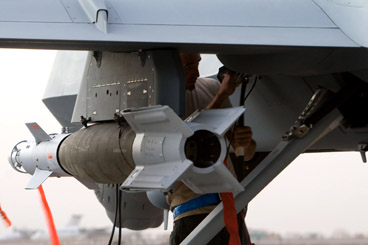 |
In Afghanistan, an aircrew member inspects a Reaper weapons load. (USAF photos) |
Creech does an excellent impression of a forward location. It’s a bare-bones facility surrounded by desert, with little in the way of housing and only one dining hall, open a few hours a day. It has two ground control stations. In years past, when it was Indian Springs Air Force Auxiliary Field, Creech was used by Nellis pilots for landing practice or as a marshaling site in large Red Flag or Gunsmoke events.
Members of the 42nd talk in terms of “caps,” which is the collection of aircraft, support gear, and persons needed to keep station for 24 hours a day, seven days a week. A Reaper “combat air patrol” requires four aircraft, one ground control station, and 10 crews, Greene said. The 42nd will be full up in 2010, when it will have six caps’ worth of capability.
Many coalition uniforms can be seen. The Royal Air Force is acquiring and operating Reapers—they perform ISR functions only—and is setting up its own facility at Creech. British operators also serve as instructors for USAF flight crews. In Afghanistan, USAF and RAF crews share Reaper infrastructure. Plans called for a January activation of RAF 39 Squadron at Creech.
The 3-1 manual—tactics for the MQ-9—is being written on a daily basis. Speaking of his weapons tactics officer, Greene said, “He compiles all the lessons learned, he debriefs the crews, and he takes those and codifies them.” Greene declined to get into the lessons learned or the tactics employed.
Creech lies close to the Army’s desert training facility at Ft. Irwin, Calif. On training missions, Reapers will launch from Creech and fly through a specially designated air corridor to the skies over the training center and then work with Army troops preparing for deployment to Afghanistan. “They’re the guys we’ll be working with when they get downrange,” Greene said.
The Air Force will say only that it has roughly 10 of the new Reapers. The “program of record” calls for buying 60 Reapers in the next few years. However, USAF added eight in the 2007 supplemental defense spending bill for use by Air Force Special Operations Command, and will add eight to the 2008 supplemental, for a total buy of 76.
Plans call for the ANG’s 174th Fighter Wing at Hancock Field, N.Y., to convert to the MQ-9, using Ft. Drum, N.Y., as the launch-and-recovery facility. An operating location for AFSOC’s Reapers hasn’t been announced.
In Fiscal 2008, the Air Force will take delivery of four MQ-9s. The delivery rate is set to increase to nine in FY 09 and reach the maximum production rate of 11 in FY10. Those numbers do not include sales to Britain, other foreign operators, or other US agencies that will fly the MQ-9.
A maintenance official whose job it is to inspect the aircraft before accepting delivery on behalf of the Air Force said the aircraft so far have been “very clean. … almost no write-ups.” In fact, changes made at delivery are usually extras requested by the Air Force—“Things that we actually asked them to do, like add some chafing protection on some wires, things not part of the original aircraft design,” the official said.
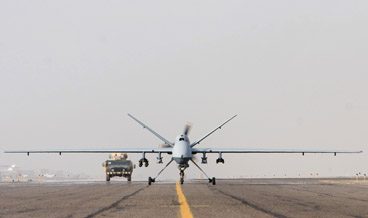 |
A Reaper takes off for a mission over Afghanistan. (USAF photos) |
Spare Parts Problems
Despite the fact that his unit has been flying combat missions since last September, Greene said the initial operational testing and evaluation of the MQ-9 is only now getting under way. Likewise, his unit won’t declare initial operational capability for about a year. The declaration of IOC involves many factors besides the readiness of flight crews: It also takes into account sortie rates, available aircraft, and a matured maintenance capability.
It is in the area of spare parts that the Reaper faces some of its biggest challenges, Greene acknowledged. Whenever a system is rushed from the factory to battle, it usually takes a while for the spare parts to catch up.
General Atomics continues to “build the spare parts and [wartime readiness] kits for us,” and occasional shortages come from “the fact that the aircraft was fielded so quickly and it has so much desired capability that we need, that it’s kind of ‘the cost of doing business.'”
MSgt. Darin Mauzy, a maintainer with the 432nd Wing, said it’s misleading to look at the maintenance facilities and see Reapers being routinely dismantled.
“It’s not that the aircraft broke,” he said, but rather that the parts are still so new that no track record of how they perform has been established. To be safe, maintainers will pull a component working perfectly well, as part of a process of collecting data on when it needs service. With more data, parts will be allowed to stay on the airplane for longer and longer periods, until there’s confidence in how long they’ll last.
“So, when you see one taken apart, it’s mostly for time-change orders,” not problems, Mauzy said. Operational test and evaluation should provide more of the knowledge needed to smooth out parts issues.
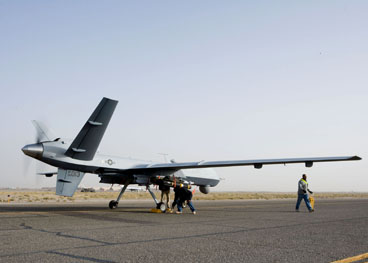 |
A Reaper aircrew performs a preflight check before a mission in Operation Enduring Freedom. (USAF photo) |
Another problem is tools. The Predator and Reaper—made mostly of composites and having little commonality with fighters—require unique tools, and there may be only two or three of a particular kind in the squadron. So, some downtime is a product of waiting for a turn with one of the gadgets that allow maintenance to be performed.
Greene said he’s pleased with the squadron’s effort to get Reaper operating. Although he is chided by pilots in other systems about flying a “video game,” he shrugs off the barbs because his unit is directly involved in the action.
“When I sit in the GCS in the seat, and I look down and I see guys on the ground over in Afghanistan, and I’m talking to them and supporting them, it’s unique and rewarding. We’re fighting the war all the time—all the time. There’s never a break.”
